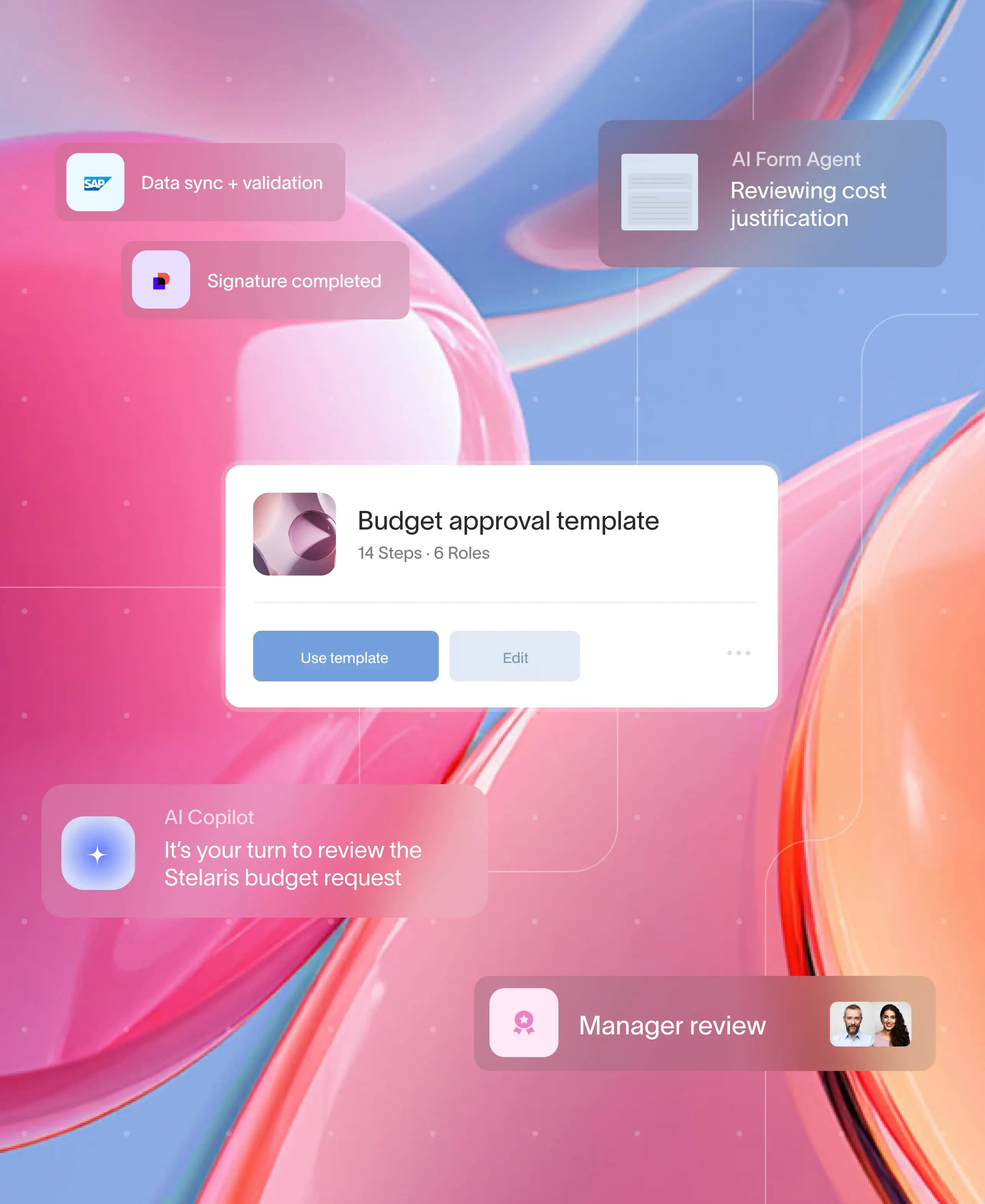.jpg)
Business processes are structured sequences of tasks or activities that guide work completion in an organization. They provide the foundation for how any business operates, from onboarding new clients to processing invoices. This ensures consistency, accountability, and efficiency in everyday operations.
Defined by their repeatability and purpose, business processes involve interconnected steps that help achieve specific goals. These could be customer-facing actions, internal administrative tasks, or strategic planning efforts. Whether automated or manual, structured business processes reduce errors, clarify roles, and streamline communication.
This article will list the different types of business processes, explain why they’re essential to long-term efficiency, and outline how businesses can better classify and manage their workflows. Understanding these processes is the first step to building a streamlined, scalable operation that focuses more on value-driving initiatives and less on manual, repetitive tasks.
What is a business process
A business process is the blueprint for how work gets done. It’s a repeatable set of tasks or actions that, when followed, drive a specific business outcome. Whether it's onboarding a client, submitting an expense report, or launching a new product, each process ensures that activities are completed consistently and efficiently. Business processes are not just operational necessities — they’re strategic assets that define how smoothly, securely, and successfully an organization functions. When these processes are mapped and understood, businesses can unlock new levels of productivity, clarity, and control.
Importance of well-defined business processes
A well-defined business process is more than just a set of steps. It is a strategic framework that ensures tasks are executed consistently, efficiently, and in alignment with business goals. When processes are mapped out, teams know exactly what to do, when, and how to move work forward without bottlenecks.
Defined processes reduce ambiguity and improve accountability. Teams are empowered to make decisions within a structured framework, which minimizes delays and prevents duplicated efforts. This clarity also creates opportunities to introduce automation, measure performance, and improve over time.
For example, in industries like finance or legal services, every task, whether onboarding a client, reviewing a contract, or sharing confidential documents, requires precision and compliance. Without a clear process in place, these businesses risk inconsistencies that can impact client trust or regulatory standing.
By identifying business processes and standardizing them, organizations lay the groundwork for growth. They reduce manual rework, support cross-functional collaboration, and free up resources to focus on higher-value initiatives.
Different types of business processes
Every organization operates through a combination of processes that fall into specific categories. While these processes vary across industries, they can be grouped into three primary classifications of business processes:
1. Core processes
These business processes are directly responsible for delivering value to customers. They encompass the essential activities that generate revenue, shape the customer experience, and fulfill the organization’s mission. Core processes include functions such as client onboarding, product or service delivery, and customer support. Because these processes have a direct impact on customer satisfaction and business performance, they are often prioritized for optimization, automation, and continuous improvement. Any breakdown in a core process can immediately affect a company’s bottom line and reputation, which is why these workflows require the most attention and investment.
2. Support processes
Support processes don’t directly deliver value to the customer but are critical to enabling and sustaining core operations. These back-office functions include human resources, IT support, facilities management, finance, legal, and procurement. Though they operate behind the scenes, support processes ensure that people, systems, and tools are in place to keep the business running smoothly. Without these workflows, core processes would stall due to a lack of infrastructure, compliance, or internal coordination. Streamlining support processes—especially through automation—can significantly improve internal efficiency and free up resources for more strategic initiatives.
3. Management processes
Management processes provide the oversight and direction needed to align business activities with organizational goals. These processes include strategic planning, risk management, compliance monitoring, budgeting, and performance evaluation. They guide leadership in making data-informed decisions and help ensure that all departments are moving toward the same objectives. Management processes may not be visible to customers, but they are essential for governance, growth, and accountability. With the right tools in place, businesses can gain visibility into these workflows and use insights to adapt quickly to market changes, regulatory demands, or performance gaps.
These 3 types of business processes provide structure for understanding how work flows through an organization. By identifying business processes in each category, businesses can better allocate resources, pinpoint inefficiencies, and prioritize improvement efforts.
In the next section, we’ll explore these business process types in more detail, along with examples of how they function in real-world scenarios.
Breaking down different types of business processes with real examples
Understanding how different business process types operate helps businesses spot inefficiencies and scale smarter. Here’s a closer look at each type of business process, with examples that bring them to life.
Core processes that drive value
These types of business processes are the engine of your business. Core business processes deliver value directly to customers and play a major role in customer satisfaction and revenue.
Examples:
- Client onboarding in industries like wealth management, where speed and accuracy are non-negotiable for building trust and starting strong relationships.
- Service delivery in marketing or consulting where projects that move from kickoff to completion across collaborative teams.
- Patient intake and care coordination in healthcare, where streamlined workflows can improve treatment timelines and patient satisfaction.
- Account management in SaaS businesses, where renewing contracts, resolving issues, and providing proactive support are essential for retention.
Platforms like Moxo are designed to keep these core business processes running without delays or drop-offs.
Support processes that keep operations moving
These types of business processes work behind the scenes, but they’re the backbone of operational continuity.
Examples:
- IT support resolves system disruptions quickly so that client work isn’t delayed.
- HR onboarding new employees and managing internal compliance workflows.
- Finance handling payroll, reimbursements, or procurement tracking.
With the right automation tools, businesses can remove repetitive admin work and give internal teams more time to focus on strategy.
Management processes that shape business direction
Management processes provide structure and strategic oversight. They guide long-term goals, ensure compliance, and monitor performance.
Examples:
- Leadership reviews to refine strategic growth plans.
- Ongoing KPI evaluation for team and company-wide performance.
- Audits and compliance workflows in regulated sectors like finance or healthcare.
Solutions like Moxo’s service orchestration platform bring visibility, consistency, and control to these high-level functions.
Not all business processes are created equal
While all the different types of business processes play a role in keeping an organization running, not every process contributes equally to value creation. The distinction lies in identifying which processes are key business processes. They directly drive growth, customer satisfaction, and competitive advantage.
Key processes align closely with the organization’s mission and revenue model. For a legal firm, this might be case execution and client onboarding. For a logistics company, it could be order management and route optimization. These are the workflows that define success and require the most attention, innovation, and optimization.
By contrast, non-value-added tasks such as internal approvals, scheduling, status updates, and follow-ups consume time without directly impacting business outcomes. When these repetitive workflows aren’t automated or streamlined, they distract teams from focusing on high-impact work.
This is where solutions like Moxo play a strategic role. Moxo helps organizations automate and orchestrate operational tasks so that internal coordination, document exchange, and client communications happen without manual back-and-forth. With standardized workflow automation, businesses can reclaim hours spent on administrative business processes and refocus their efforts on what moves the needle.
Measuring the success of your business processes
Knowing whether a business process is effective requires more than intuition. The success of any business process should be measured using specific metrics that align with its purpose. It can be operational efficiency, customer experience, or compliance. These insights allow organizations to refine their workflows and allocate resources where they have the most impact.
Key metrics to evaluate process performance
- Cycle time: Measures how long it takes to complete a process from start to finish. A shorter cycle time typically indicates higher efficiency.
- Error rate: Tracks the number of mistakes or rework required during a process. Lower error rates reflect better training, clearer procedures, or successful automation.
- Cost per process: Assesses the financial resources consumed to complete a task or workflow. Understanding cost helps prioritize improvements in high-expense areas.
- Satisfaction score: Evaluates how internal teams or clients perceive the process. This can include client onboarding feedback, service delivery ratings, or employee sentiment.
- Compliance adherence: Especially important in industries like finance or legal, this measures how well the process aligns with required standards and regulations.
Many organizations now embed performance tracking directly into their workflows using orchestration tools like Moxo. These systems provide visibility across processes and allow real-time monitoring of delays, touchpoints, and task ownership. This makes it easier to course-correct and improve.
How Moxo transforms business process automation
Streamlining business processes is about reclaiming time for the work that matters. Moxo helps businesses automate the repeatable, coordinate the complex, and elevate the client experience within a secure, centralized platform.
Whether it’s internal coordination or client-facing workflows, Moxo provides standardized experiences that minimize manual effort and reduce operational drag. With built-in process orchestration and automation tools, businesses can eliminate delays caused by email threads, missed follow-ups, or fragmented communication.
Automating non-value-add tasks
Moxo simplifies administrative work that consumes time but adds little strategic value. Examples include:
- Collecting signatures and documents during client onboarding.
- Automating checklists and approvals in service delivery.
- Coordinating financial reviews and uploads for accounting firms.
By automating these touchpoints, teams spend less time chasing status updates and more time on advisory, creative, or strategic work.
Refocusing on key business processes
The time saved through automating non-value-added tasks can be redirected toward optimizing key business processes. It can be refining your client journey, launching new services, or building a scalable growth strategy. With Moxo’s workflow automation, businesses can build customized flows, assign roles, set deadlines, and track outcomes in a way that aligns with their unique needs.
Moxo’s role as a service orchestration platform ensures that each type of business process moves forward without friction. This helps teams do more with less.
Orchestrate smarter workflows for efficient business processes. Get started with Moxo.
Conclusion
Understanding the different types of business processes is essential to running an efficient, scalable business. From core processes and workflows that deliver value to clients to support and management processes that ensure long-term sustainability, each type of business process plays a unique role in business success.
Not all processes deserve equal attention. The ability to identify key business processes and eliminate inefficiencies in non-value-added workflows can be the difference between growth and stagnation. When businesses invest in optimizing these processes through structured automation, they unlock more time, better visibility, and stronger outcomes.
Moxo helps organizations move towards that future. By orchestrating workflows, reducing manual coordination, and ensuring accountability at every step, Moxo enables businesses to streamline their operations.
Orchestrate smarter workflows for efficient business processes. Get started with Moxo.
FAQs
What are the types of business processes used in organizations?
Organizations mainly use three types of business processes – core, support, and management. Each type of business process serves a specific purpose in value creation, internal operations, or strategic direction.
Why does defining different types of processes help improve efficiency?
When business processes are clearly defined, teams understand their roles, automation becomes easier to implement, and performance can be consistently measured and refined.
How can automation support non-value-added business process types?
Automation reduces time spent on repetitive admin tasks, approvals, or updates. This allows teams to focus on strategic, value-driving processes instead.
How does Moxo support different business processes through its platform?
Moxo’s platform enables businesses to streamline and automate workflows across client onboarding, service delivery, internal operations, and more, reducing friction and enhancing performance.





